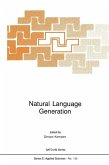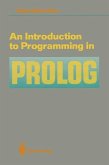40,95 €
40,95 €
inkl. MwSt.
Sofort per Download lieferbar

20 °P sammeln
40,95 €
Als Download kaufen

40,95 €
inkl. MwSt.
Sofort per Download lieferbar

20 °P sammeln
Jetzt verschenken
Alle Infos zum eBook verschenken
40,95 €
inkl. MwSt.
Sofort per Download lieferbar
Alle Infos zum eBook verschenken

20 °P sammeln
- Format: PDF
- Merkliste
- Auf die Merkliste
- Bewerten Bewerten
- Teilen
- Produkt teilen
- Produkterinnerung
- Produkterinnerung

Bitte loggen Sie sich zunächst in Ihr Kundenkonto ein oder registrieren Sie sich bei
bücher.de, um das eBook-Abo tolino select nutzen zu können.
Hier können Sie sich einloggen
Hier können Sie sich einloggen
Sie sind bereits eingeloggt. Klicken Sie auf 2. tolino select Abo, um fortzufahren.

Bitte loggen Sie sich zunächst in Ihr Kundenkonto ein oder registrieren Sie sich bei bücher.de, um das eBook-Abo tolino select nutzen zu können.
The authors explore current thinking in the search for machine understanding of human languages. The book begins with a summary of basic methodology and concludes with a description of experimental learning mechanisms and some example programs in PROLOG.
- Geräte: PC
- ohne Kopierschutz
- eBook Hilfe
- Größe: 76.62MB
Andere Kunden interessierten sich auch für
![Natural Language Generation (eBook, PDF) Natural Language Generation (eBook, PDF)]() Natural Language Generation (eBook, PDF)232,95 €
Natural Language Generation (eBook, PDF)232,95 €![Computational Models of Mixed-Initiative Interaction (eBook, PDF) Computational Models of Mixed-Initiative Interaction (eBook, PDF)]() Computational Models of Mixed-Initiative Interaction (eBook, PDF)112,95 €
Computational Models of Mixed-Initiative Interaction (eBook, PDF)112,95 €![Understanding the Artificial: On the Future Shape of Artificial Intelligence (eBook, PDF) Understanding the Artificial: On the Future Shape of Artificial Intelligence (eBook, PDF)]() Understanding the Artificial: On the Future Shape of Artificial Intelligence (eBook, PDF)62,95 €
Understanding the Artificial: On the Future Shape of Artificial Intelligence (eBook, PDF)62,95 €![AI and Cognitive Science '92 (eBook, PDF) AI and Cognitive Science '92 (eBook, PDF)]() AI and Cognitive Science '92 (eBook, PDF)40,95 €
AI and Cognitive Science '92 (eBook, PDF)40,95 €![Catalogue of Artificial Intelligence Tools (eBook, PDF) Catalogue of Artificial Intelligence Tools (eBook, PDF)]() Catalogue of Artificial Intelligence Tools (eBook, PDF)72,95 €
Catalogue of Artificial Intelligence Tools (eBook, PDF)72,95 €![The Informational Complexity of Learning (eBook, PDF) The Informational Complexity of Learning (eBook, PDF)]() Partha NiyogiThe Informational Complexity of Learning (eBook, PDF)72,95 €
Partha NiyogiThe Informational Complexity of Learning (eBook, PDF)72,95 €![An Introduction to Programming in Prolog (eBook, PDF) An Introduction to Programming in Prolog (eBook, PDF)]() Patrick Saint-DizierAn Introduction to Programming in Prolog (eBook, PDF)40,95 €
Patrick Saint-DizierAn Introduction to Programming in Prolog (eBook, PDF)40,95 €-
-
-
The authors explore current thinking in the search for machine understanding of human languages. The book begins with a summary of basic methodology and concludes with a description of experimental learning mechanisms and some example programs in PROLOG.
Dieser Download kann aus rechtlichen Gründen nur mit Rechnungsadresse in A, B, BG, CY, CZ, D, DK, EW, E, FIN, F, GR, HR, H, IRL, I, LT, L, LR, M, NL, PL, P, R, S, SLO, SK ausgeliefert werden.
Produktdetails
- Produktdetails
- Verlag: Springer London
- Seitenzahl: 358
- Erscheinungstermin: 6. Dezember 2012
- Englisch
- ISBN-13: 9781447116974
- Artikelnr.: 44052569
- Verlag: Springer London
- Seitenzahl: 358
- Erscheinungstermin: 6. Dezember 2012
- Englisch
- ISBN-13: 9781447116974
- Artikelnr.: 44052569
- Herstellerkennzeichnung Die Herstellerinformationen sind derzeit nicht verfügbar.
1 Art, Science and Engineering.- Cognitive Structures.- Scientific Method.- Language is Contrastive.- 2 Metaphor as a Cognitive Process.- Conjecture and Refutation, Theories and Hypotheses.- Specialization and Abstraction, Induction and Generalization.- Partial Analysis and Noise.- The Importance of Errors and Restrictions.- 3 Psychology and Psycholinguistics.- The Observable Processes of Acquisition.- External Influences: Parents, Imitation, and Correction.- Expansion and Reduction.- 4 Language Defects and Correction.- Rate and Order of Learning.- Telegraphic Speech.- Parents and Teachers: Good and Bad Examples.- Reinforcement: Punishment and Reward.- 5 Cognition and Restriction.- The Cognitive Processes of Language Acquisition.- The Magical Number Seven.- Memory and Capacity Phenomena.- Adult Characteristics.- 6 Nativism and Constructivism.- Representations: Deep Structure and Language Acquisition.- Acquisition Models, Chomsky and Piaget.- Computer Programs as Psychological Models.- 7 Neurology and Neurolinguistics.- Neuroanatomy: Brains, Neurons, and Synapses.- Neurophysiology and the Effects of Plasticity.- Neural Communication and Languages of the Brain.- Neural Nets: Connectionistic and Locationistic Models.- 8 The Nature of Language.- The Quintessence of Language.- Epistemology, Phonology, and Prosody.- Culture, Perspectives, and Metaphor.- 9 The Mechanics of Language.- Contrast and Similarity: Paradigmatic Learning and Context.- The Structures of Language.- Models of Grammar.- 10 The Ubiquity of the Sentence.- Pronouns and Anaphora.- Recursion of Syntax and Parsing.- Transformational Grammar.- Generative Grammar.- Learning Process and Idiolect.- 11 Computer Science and Artificial Intelligence.- Pattern Recognition, Problem Solving and Heuristic Search.- LearningStrategies.- Problems and Theoretical Limitations.- 12 Heuristics and Analytic Intransigence.- Automata and Formal Languages.- Methodologies: Implementation vs Experimentation.- Cybernetics and Robotics.- Deletionless Strategies.- Formalisms.- Clauses: Horn and non-Horn, unit and non-unit Systems: LUSH and PROLOG.- 13 Postulates, Claims and Hypotheses.- The Bases of Meaning and Learning.- The Organization of Concepts in Learning.- The Process of Learning.- The Artificial Subsumes the Natural.- 14 Computer Modelling Experiments.- Batteries One to Seven.- A Generalized Toy World Package.- Partial Analysis of NLA.- Future Systems.- Conclusions.
1 Art, Science and Engineering.- Cognitive Structures.- Scientific Method.- Language is Contrastive.- 2 Metaphor as a Cognitive Process.- Conjecture and Refutation, Theories and Hypotheses.- Specialization and Abstraction, Induction and Generalization.- Partial Analysis and Noise.- The Importance of Errors and Restrictions.- 3 Psychology and Psycholinguistics.- The Observable Processes of Acquisition.- External Influences: Parents, Imitation, and Correction.- Expansion and Reduction.- 4 Language Defects and Correction.- Rate and Order of Learning.- Telegraphic Speech.- Parents and Teachers: Good and Bad Examples.- Reinforcement: Punishment and Reward.- 5 Cognition and Restriction.- The Cognitive Processes of Language Acquisition.- The Magical Number Seven.- Memory and Capacity Phenomena.- Adult Characteristics.- 6 Nativism and Constructivism.- Representations: Deep Structure and Language Acquisition.- Acquisition Models, Chomsky and Piaget.- Computer Programs as Psychological Models.- 7 Neurology and Neurolinguistics.- Neuroanatomy: Brains, Neurons, and Synapses.- Neurophysiology and the Effects of Plasticity.- Neural Communication and Languages of the Brain.- Neural Nets: Connectionistic and Locationistic Models.- 8 The Nature of Language.- The Quintessence of Language.- Epistemology, Phonology, and Prosody.- Culture, Perspectives, and Metaphor.- 9 The Mechanics of Language.- Contrast and Similarity: Paradigmatic Learning and Context.- The Structures of Language.- Models of Grammar.- 10 The Ubiquity of the Sentence.- Pronouns and Anaphora.- Recursion of Syntax and Parsing.- Transformational Grammar.- Generative Grammar.- Learning Process and Idiolect.- 11 Computer Science and Artificial Intelligence.- Pattern Recognition, Problem Solving and Heuristic Search.- LearningStrategies.- Problems and Theoretical Limitations.- 12 Heuristics and Analytic Intransigence.- Automata and Formal Languages.- Methodologies: Implementation vs Experimentation.- Cybernetics and Robotics.- Deletionless Strategies.- Formalisms.- Clauses: Horn and non-Horn, unit and non-unit Systems: LUSH and PROLOG.- 13 Postulates, Claims and Hypotheses.- The Bases of Meaning and Learning.- The Organization of Concepts in Learning.- The Process of Learning.- The Artificial Subsumes the Natural.- 14 Computer Modelling Experiments.- Batteries One to Seven.- A Generalized Toy World Package.- Partial Analysis of NLA.- Future Systems.- Conclusions.







